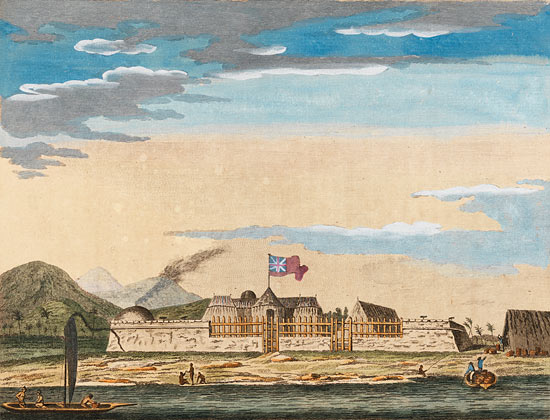Cook's Endeavour voyage and the British discovery of Australia
 Venus Fort, Erected ... during the Observation of the Transit of Venus at Otaheite from A journal of a voyage to the South Seas by Sydney Parkinson. London, 1784, Hand coloured print. Q78/10
Venus Fort, Erected ... during the Observation of the Transit of Venus at Otaheite from A journal of a voyage to the South Seas by Sydney Parkinson. London, 1784, Hand coloured print. Q78/10Captain James Cook (1728-1779) was given command of the Endeavour in 1768 and set sail from Plymouth in August of that year on Britain's first great voyage of ocean exploration. The expedition was mounted by the Admiralty and the Royal Society. The main aim was to chart and explore the Pacific Ocean and to observe and record the transit of Venus across the sun in April 1769 from Tahiti.
The second goal of the journey was to chart the coastlines of the islands visited in the South Pacific and to take detailed scientific observations about the land, its flora and fauna and the local indigenous peoples. The final and secret aim of the expedition was to for Cook to locate and claim the Great South Land. The secret instructions, which Cook carried with him, were orders from the British Admiralty to seek 'a Continent or Land of great extent' and to take possession of the country ‘in the Name of the King of Great Britain'.
After sailing up the west coast of New Zealand, proving that it did not form part of a large southern continent, as Abel Tasman had proposed, Cook sailed west and reached the southern coast of New South Wales in April 1770. He then sailed north, charting the eastern coastline of Australia, finally claiming the land for Great Britain at Possession Island on 22 August 1770. Cook described his discoveries and experiences in his logbook. Copies of this log were required to be sent back to the Admiralty at various ports to report on the expedition’s progress. The State Library holds the copy sent to the Admiralty from Batavia (now Jakarta, Indonesia).
Cook’s journal describes in detail the discoveries of the expedition. Bound into the back of the Mitchell Library's copy of Cook's log are several printed maps relating to the discoveries made on Endeavour, including maps of Botany Bay and Endeavour River. They were produced after the expedition returned to England and it is not known when they were bound in with the log.
> Examine the maps included in Cook's log
A group of gentlemen scientists also travelled with the Endeavour in order to record, observe and collect plant and animal material as well as cultural items from the various local people the ship encountered. The scientific work was financed and directed by a wealthy young gentleman botanist, Joseph Banks, who later became one of the most influential men of his day. Banks contributed to the expedition from his personal fortune and outfitted the scientists with a fine reference library, collecting equipment and ample space on board ship to store specimens and work.
Banks also kept a journal on board Endeavour. His original observations of the land and people, plants and animals contribute significantly to our understanding of Australia before European settlement.
> Read selections from Joseph Banks’ Endeavour journal
Banks’ scientific staff included Swedish naturalist Daniel Solander and scientific illustrator Sydney Parkinson. James Roberts was Banks’ servant. He also kept a journal on board Endeavour.
> View selections from James Roberts' journal
Sydney Parkinson was one of the scientific artists on board the Endeavour. He specialised in botanical and natural history drawing, while the other artist, Alexander Buchan was responsible for landscapes and coastal views. Unfortunately, neither artist survived the journey. Buchan died in April 1769 and was buried at sea. Parkinson created hundreds of sketches and paintings during the three years voyage, many of which survive. His most famous works are the botanical drawings used to illustrate Banks’ Florilegium. Parkinson died at sea in January 1771 after contracting dysentery.
> View published plates by Sydney Parkinson
Although Cook’s Endeavour voyage visited and took possession of Australia for Great Britain, many still believed that the legendary Great South Land was yet undiscovered.
> View the first printed map to show the east coast of Australia






